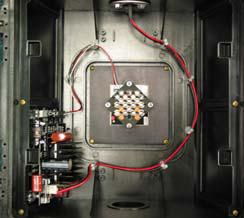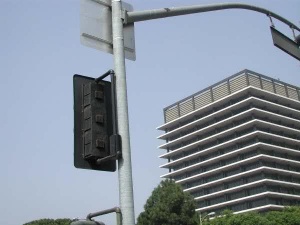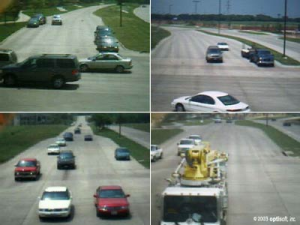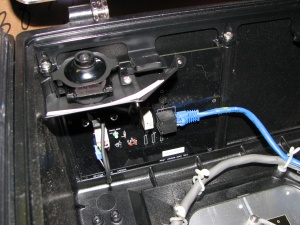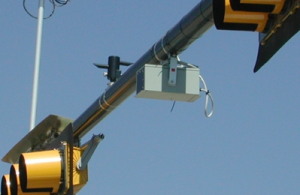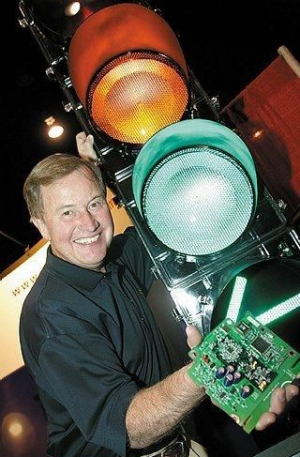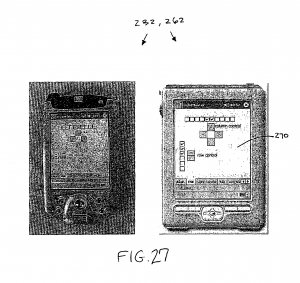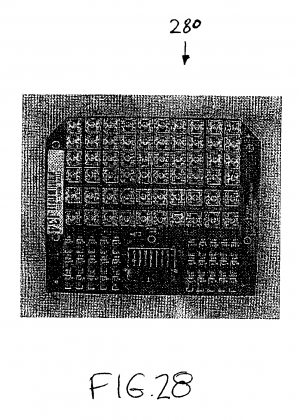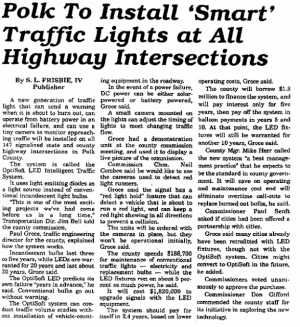Optisoft
Contents
Introduction

OptiSoft was founded in 1997 under the name Power Signal Technologies. It is not known when the name change to OptiSoft took place or why. The company was founded by Mike Hutchison, and led by CEO and former chairman of Compaq Computer Corporation Ted Enloe. The company was based in Richardson, Texas. OptiSoft's slogan was "The Intelligent Traffic Platform", as its traffic signal products were designed for both traffic control, and advanced homeland security tools. OptiSoft produced only vehicle and pedestrian signals. They did not design controllers.
Early Development
The earliest OptiSoft signal heads were fairly basic in design. The housing had electronics only to light the LED board, and one integrated power filter and LED driver board. The back of each signal section incorporated heat sinks to allow heat to dissipate into the outside atmosphere. The earliest units, possibly even prototypes, has small heat sinks, later models had larger heat sinks.
Innovations
OptiSoft signal heads were one of the first fully LED, Energy Star qualified, signal head, as well as the first to incorporate an incandescent look design over matrices of diodes common during the late 1990s. Only a few high powered LEDs positioned a distance from a fresnel, pixelated lens provided the full color for the indication.
OptiSoft also pioneered a feature called "Red Light Hold".
This feature was designed to use detection to see if vehicles were in the intersection after the signal turned red. The controller would hold red until all traffic exited the intersection before releasing cross traffic. This feature is recently seeing new life as an optional feature in many traffic signal controller units, such as the Siemens M50. Siemens calls this feature "Red Protect" and operates the same way.
Homeland Security
The selling point to OptiSoft vehicle signals was their ability to house embedded video cameras and other sensors.
The video cameras were positioned in the lower left hand portion of the doors, while the upper right corner had an ambient sensor. These cameras were mostly designed for surveillance.
During the day the cameras shot video in color, and at night the cameras switched to high res black and white. Video from these cameras could be stored, or sent via ethernet to traffic control center or police station. External control units installed elsewhere, such as the intersection cabinet, could be used for advanced functions for the cameras like stop bar vehicle detection, red light hold, or traffic counters. OptiSoft cameras were shown briefly in a Modern Marvels episode titled "Surveillance" The first major sensor outside the cameras was the gunshot detector, developed for OptiSoft by Planning Systems Incorporated of Virginia. Housed inside the signal head, these sensors detected short-burst sounds at specific frequencies: gunshots.
OptiSoft received some media attention for the innovation at stations in Washington DC. The developers of the sensors stated the unit could decipher between gunshots and other loud burst noises like firecrackers. It is not known how well the gunshot sensors worked, or if they worked as advertised at all.
Undeveloped Innovations
Many features for the OptiSoft signal head never made it past the engineers' drawing boards. These include camera software for license plate recognition, bio-terrorism sensors for detection airborne viruses and toxic particles, and biometrics for detection and recognition of faces. Car crash and red light photo enforcement were also not developed. All these features were advertised for future release.
OptiSoft did not produce an Electronically Steerable Beam signal head, but did have one in development. But due to the company's failure, the signal was not released past development. The internals were similar to that of the version made by Intelight, who bought the rights to the OptiSoft equipment.
The Pedestrian Signal Failure
OptiSoft did not produce a pedestrian signal using their existing housing. Instead, they developed an LED based retrofit kit to install in ICC or McCain 16" x 18" housings. The City of Los Angeles, California contracted OptiSoft to install their LED based pedestrian signals across the city. The city paid OptiSoft as much as $9 million for the rollout.
The first version of this signal has several significant design issues. The electronics in the "hand" indication tended to burn out prematurely during the flashing dont walk interval. Another major issue was the signal was not equipped to handle high fluctuations in the city grid. Designed for 600 volt protection, the grid could surge to 2000 volts on occasion, burning out the electronics.
OptiSoft initially began repairing and replacing the bad units but eventually stopped due to lack of money. The city eventually settled a legal case against the company, for an unknown amount of money.
OptiSoft developed a second version of the pedestrian signal which had a much cleaner design to it. The flaws were fixed and the signal provided brighter indications. But at this point, they were bleeding money and the new version only saw minimal production
OptiSoft's First Contract
In about 2002, Polk County, Florida contracted with OptiSoft to have their vehicle and pedestrian signals installed at all he intersections in the county. OptiSoft did not follow through with the order as they did not feel the company would have enough money to fulfill the contract obligations.
Layoffs, Denial, and OptiSoft declines
Ted Enloe of OptiSoft defended the company as it began declining. He argued the failures with the Los Angeles project was due to the signal units being in a beta stage of development.
As the company began falling apart, in February 2005, OptiSoft laid off half of their staff; mainly in engineering and development. Enloe stated that their products "were developed...and the company was focusing on sales and marketing"
OptiSoft shut down its Richardson based facility in March of 2005, and Comerica bank seized the company's assets.
Relationship with Intelight
Intelight was a totally separate entity from OptiSoft. Intelight was founded in 2006 by former Siemens ITS program manager Craig Gardner, and is based out of Tucson, Arizona.
Intelight bought the rights to the OptiSoft products, and fully developed and marketed the Electronically Steerable Beam signal head. They made some modifications to the signal including updated firmware, and some physical modification to the housing, heat sink, lens and door. They brought the Electronically Steerable Beam to full production and has become one of their flagship products.
The OptiSoft vehicle signal was produced very early in Intelight's run, as was a version that used standard door-mounted LED modules fitted into the housings. The heat sink was not used in this version; the backside was blanked out where the heat sink would have been installed. This version was primarily sold to OMJC signal for their products. Both these products were quickly discontinued, but the latter eventually came back as their HAWK signal product.
They did not continue to produce a pedestrian signal, instead they focused on technology innovation in the controller and software end of the spectrum.
Intelight discontinued most of the sensor options for the ESB head and did not continue with producing the other sensors. The camera option still available for real time video only. It is very rarely included and may be phased out.

